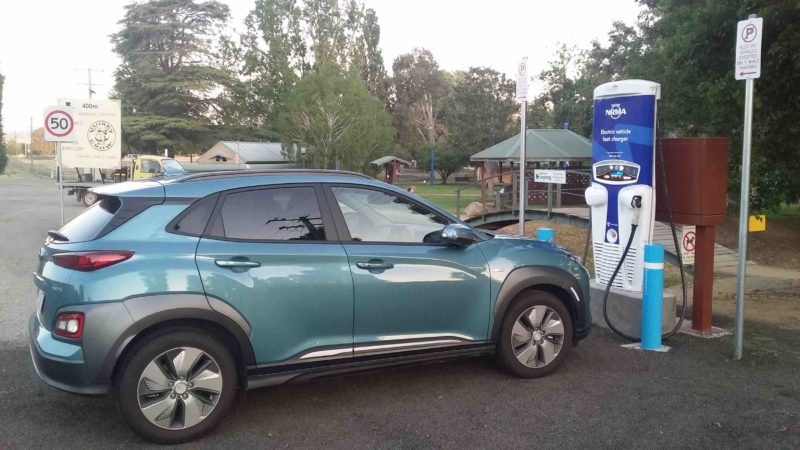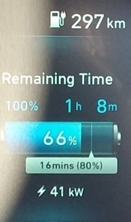The death of range anxiety in electric vehicles

It’s a myth encouraged during the recent election campaign (“you’d be better off walking to Dubbo”) and ever since. But early adopter battery electric vehicle owners have long known that this is not the case.
The Range Anxiety label was created when those first BEVs were put into the hands of motoring writers and others unfamiliar with the technology.
Unsurprisingly, they approached them like an internal combustion engine (ICE) car and followed the paradigm of refuelling only when forced by a low fuel warning to go to a refuelling station. They were then apparently surprised that a petrol pump nozzle didn’t fit into a charging socket.
And just like moving from hay mangers to petrol pumps, the change from ICE to BEV and battery charging requires a paradigm shift in thinking about refueling.
For the vast majority of trips, you no longer have to go out of your way to find a petrol station, stop, sometime wait and then stand by your car as it refills at a petrol station, and then pay for the privilege of standing in any weather to do so.
But it did need you to shift your thinking from forced refilling stops to ‘opportunity charging’ when out and plugging in to charge when at home.
It is true that early BEVs such as the Nissan Leaf or Mitsubishi iMiEV had only a range of 100–140km – limiting them to a suburban driving role with the need to keep an ICE vehicle for longer trips.
That, of course, did not stop their more intrepid owners doing some very long trips indeed – as exemplified by the many contenders for the Australian Electric Vehicle Association’s Glen George Trophy.
As an example, in 2017 it was awarded to an iMiEV that traveled from Adelaide to Devonport: only just beating a Leaf traveling from Port Stevens in NSW, with both trips being done before DC fast chargers were available outside of city centres.
It is also worth noting that BEVs never ‘suddenly’ run out of charge: they give constant reminders of the remaining estimated range.
They also offer (or even automatically slip into) eco modes for low battery and ultimately apply a ‘turtle’ mode to get you a few kilometres more to a power point/EVSE is you persist in ignoring all other warnings.
However, the Range Anxiety label was created, and it stuck as a description for the inability of BEVs to travel long distances easily, and the inability to access DC fast-chargers on major (or in fact any) out of town routes.
But that was back in 2011/12, and a lot has happened since.
Nowadays, you are less likely to be surprised by a low fuel warning in a BEV than in an ICE vehicle – and far more capable of reaching an EV refuelling option that meets your needs if that happens.
So what’s changed?
Firstly, BEV batteries are now three to six times the size of those early ones (iMiEVs were 16kWh and early Leafs were 24kWh: the current Kona electric is 64kWh, the Model S Long Range 100kWh).
With efficiency improvements as well, these cars are capable of easily doing 400 – 600km on a full charge. For most daily usage, that means the occasional overnight charge is plenty.
Opportunity charging is a thing of the past – unless you want to.
For those without off-street parking, opportunity charging or a once-weekly DC fast-charge to 80% would still be plenty for a week of driving.
Another improvement is in the data provided by the car itself.
Dashboard range estimates have evolved well beyond the GOM (Guess-O-Meter) as the early Leaf range-estimators were nicknamed.
The data readouts in a BEV (fig. 1) are now direct analogues of the existing gauges and data provided in a modern ICE car. Instead of a fuel gauge, you have a state-of-charge gauge.
Instead of a litres/100km usage estimate (either instantaneous or averaged for the trip), you have kWh/100km.
Also, just like an ICE car, you get remaining range estimates based on current driving patterns and remaining charge. (And these are proving to be very accurate – unlike the early Leaf GOM).
On top of this, modern BEVs with their SatNav systems are able to locate and direct you to the nearest charger if you ask it to.
(Unfortunately, with both DC and AC charging networks rolling out so fast now – the moment they go into an EV computer they are out of date – but Apps like PlugShare fill in that gap).

DC fast-charging to 80% in 20 – 40 minutes is now the norm along these routes. (Just the right amount of time to get in that coffee, meal and toilet stop and safely proceed again).
To be able to monitor your car charging from your chair, bed or restaurant is so much easier than being a ‘pump-attendant’ to your car waiting for it to fill up).

Current range:top (297 in this case)
Time to 100% charged: above battery image.(1h, 8 min)
Time to 80% charged: underneath battery image.(16 minutes)
Instantaneous charging rate: at bottom. (41kW)
In summary, it is high time to call ‘Time’ on Range Anxiety.
Certainly, in my 12,000km so far of driving a Kona electric – including one circumnavigation of Victoria, two trips to Sydney (one including a trip to Coffs Harbour and then back to Melbourne via Dubbo to avoid bushfires on the coast) – I have not been any more worried about running out of charge than I would have been for running out of petrol.
The difference is a change of mindset: instead of looking for petrol stations, I look for my refueling options on PlugShare, DC charging network Apps or just plug-in at my overnight stay.

Bryce Gaton is an expert on electric vehicles and contributor for The Driven and Renew Economy.
He has been working in the EV sector for 10 years, and also is editor
of the Australian Electric Vehicle Association newsletter.
No comments:
Post a Comment